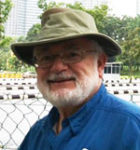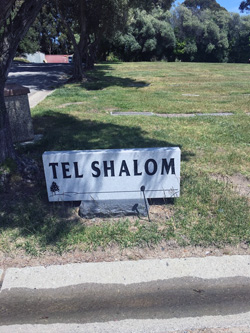© Oliver B. Pollak


RICHMOND, California — My academic introduction to Jewish cemeteries dates back to a paper delivered by Iowa State University anthropology professor David Gradwohl at the Missouri Valley History Conference in Omaha in the late 1970s. Ritual burial and respect for the dead are integral to the Jewish faith. Grave stones are placed above the interred about a year after the funeral, time enough for the family to settle on the design, tribute and words.
Jewish congregations obtain land independently or negotiate to become part of, but separate from, a larger multi-faith regional cemetery.
The Jewish communities in Contra Costa County maintain three cemeteries. The Oakmont Memorial Park in Lafayette established in 1951 has two sections devoted to Lafayette’s Reform Temple Isaiah founded in 1951.
Rolling Hills Memorial Park in Richmond, established in 1960, has about 50,000 interments.
Richmond’s Temple Beth Hillel and Berkeley’s Congregation Beth El, both Reform congregations, opened the Tel Shalom section in 1968. It has 14 rows of 55 plots, for a total of about 800 in flush grave markers. There are no above ground monuments. Opposite Tel Shalom is Bethel, a Christian burial ground. The following account of Tel Shalom aggregates and does not distinguish between Beth Hillel and Beth El congregants.
As the older cemeteries were pressing the limits of space they opened Gan Shalom in Briones on 2006, a solely Jewish cemetery. It serves Lafayette’s Reform Temple Isaiah, Walnut Creek’s Conservative Congregation B’nai Shalom, and the Tel Shalom Burial Association serving Beth Hillel and Beth El.
Bronze and stone life markers reveal the decedents name and sometimes Hebrew name. The birth and death dates span a life. Spouses lie side by side. Further text and symbols thicken the life story giving rich and sometimes illusive hints to the person’s life, qualities, accomplishments, marriage, children, siblings and grandchildren.
Iconography included Stars of David, menorahs, two entwined rings indicating the year of marriage, 1935 and 1945, twelve tribes, a bird, grand piano, sailboat and musical notes, flower pot, mountain relief, decorative borders of leaves, vines, filigree and tracery, tractor lawnmower, dog, dog and cat, scales of justice, cello and baseball mitt.
Text established a perpetual representation. Legal professionals where clearly identified as Judge Joseph Genser 1972, or alluded to as in “Fighter for justice,” and “Seek justice undo oppression.” Ten were identified as MD or physician. The eternal message on stone and bronze included “Desalinization research pioneer.” animal activist, coach and advocate, “Passionate artist whose work elicited deep emotions in response to the spectrum of Human behavior.” Three teachers, two Ph.D’s, a mentor, artist, poet, musician, “Our Renaissance Man,” “Physician, artist, paterfamilias, ‘this was a man,’” 1912-94, “teacher and humanist,” gifted artist, “teaching and community.”
A separate stone, “Killed at Auschwitz 1944,” offered deep remembrance for murdered parents and sister. Two markers contained Holocaust Survivor symbols. Birthdates and name spelling on many stones strongly suggested escape from Nazi hell, even though the stone was otherwise silent. The single word “Shalom” appeared twice; peace, hello, goodbye, all of the above.
Birth origins spanned the globe: Hungary, Lodz and Radom, Poland, two from Cairo, two from Coburg, Giessen, Bogota, Odessa, and Vladivostok, and one family with members born in Cairo, Bulgaria, and Istanbul. A few listed residence at death; Berkeley, Huntington Beach, Oakland, Richmond, Saratoga, and Walnut Creek.
“Mother, wife, scientist, modern woman 1941-2012,” and “Nobody kvells like Adele feminist 1924-2016” articulated the changing status of women.
Thirty-one stones, about four per cent of the markers, recorded military service. Did the decedent ask to be so remembered or did a wife of child request it? Was it their most honorable legacy or what he talked about most? Did their experience traumatize and disable them? Did they get disability benefits and the use of Veterans Administration for medical care? No one died while wearing the uniform.
Three World War I veterans, seventeen World War II, one veteran who served in World War II, Korea, and Vietnam..Seventeen served in the Army; two in the Army Air Force; seven in the Navy; and one Marine. Coast Guard, Merchant Marine and women were absent. They were enlisted and drafted. There were four privates, three corporals, four sergeants, one staff sergeant, one Warrant Officer, one Signal Corps Captain, a Major, two lieutenant colonels and one colonel. The Navy job titles (ratings) included three Yeomen and a Fire Control Man.
These 31 veterans are not the total veteran cohort, “The Greatest Generation” buried at Tel Shalom for instance does not identify Judge Genser as a WWII veteran. We don’t know if they joined the American Legion, Veterans of Foreign Wars, and the Jewish War Veterans of the United States or flew Old Glory on national holidays. Family and faith determined burial at Tel Shalom rather than at a military cemetery. Perhaps some veteran funerals included a uniformed bugler, pall bearers, a gun salute, and the presentation of an American flag.
As I travel in a couple of days in Germany, I wonder how many of the Army and Army Air Force guys marched and flew over Germany. In 1985 President Reagan caused consternation by visiting Bitburg German military cemetery, a two-hour drive from Cologne.
The names on five stones belong to those who cared for our souls, cultural heritage and care in old age: Rabbi Sholom Groesberg, “Music, Friendship & Tikkun Olam;” Rabbi David William Pearlman, “Beloved husband father grandfather and rabbi;” Seymour Fromer, “Collector, protector, Magnes Founder and Director” and his wife, Rebecca Camhi Fromer, “teacher, writer, human rights activist;” and Jacques and Esther I. Reutlinger who gave their name to the Reutlinger Community in Danville.
Life’s struggles rise from the stone and metal. “It is not yours to complete the task, neither may you lay it down;” and “Husband, Father, Grandfather, Friend, Democrat. He gave of himself for what he believed in. He dreamt of a world where poverty and war are banished, with equality and justice for all people. This was his passion, his life work. His life made a difference.”
Laurette Goldberg’s (1932-2005) double size plaque curated her own legacy with 25-lines of text describing her early music expertise and closes with two lines of music. One stone posed an enigma, “Kings for such a tomb…” sounds prophetic but searching did not locate a source. Temple Beth Hillel’s Rabbi Dean Kertesz’s “little quick search” revealed it is the final couplet in John Milton’s 1630 sixteen-line poem, “On Shakespeare,” — “And so sepúlchred in such pomp dost lie, That kings for such a tomb would wish to die.”
*
Pollak, a professor emeritus of history at the University of Nebraska at Omaha, is a freelance writer now based in Richmond, California. He may be contacted via oliver.pollak@sdjewishworld.com